
Deposition Date
2023-05-09
Release Date
2023-08-16
Last Version Date
2023-08-23
Entry Detail
PDB ID:
8OZC
Keywords:
Title:
cryoEM structure of SPARTA complex heterodimer apo
Biological Source:
Source Organism:
Maribacter polysiphoniae (Taxon ID: 429344)
Host Organism:
Method Details:
Experimental Method:
Resolution:
4.00 Å
Aggregation State:
PARTICLE
Reconstruction Method:
SINGLE PARTICLE


